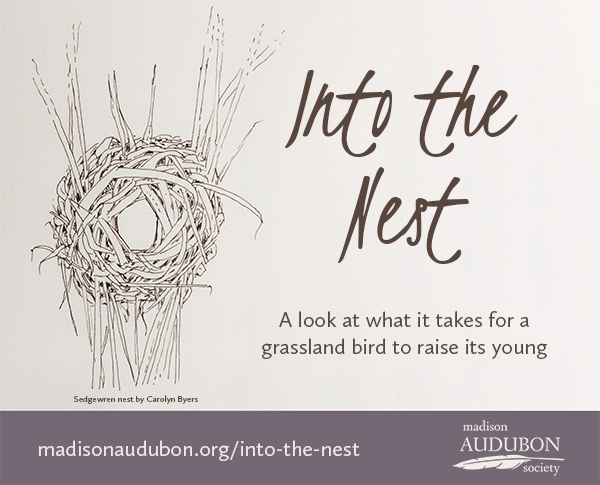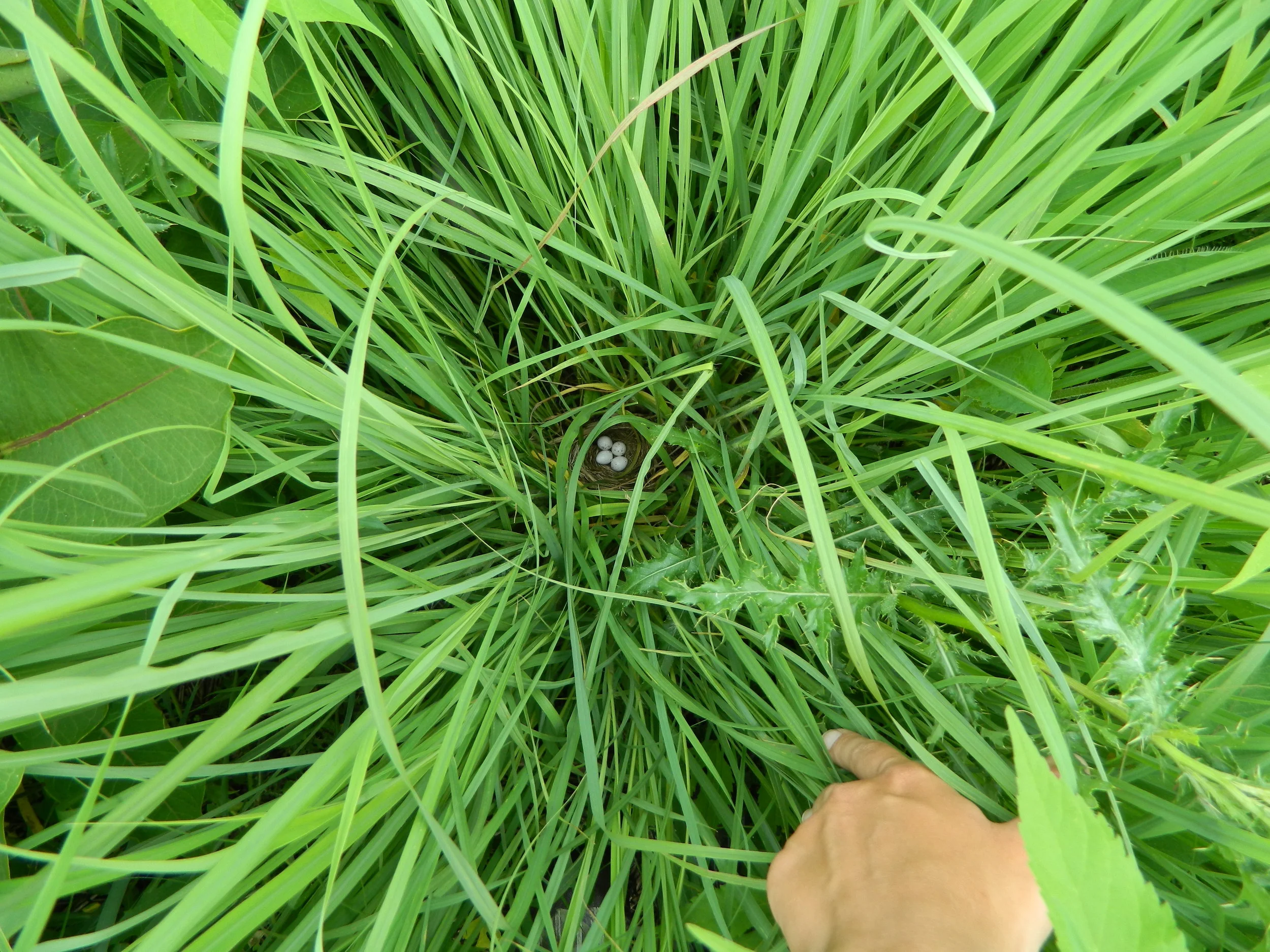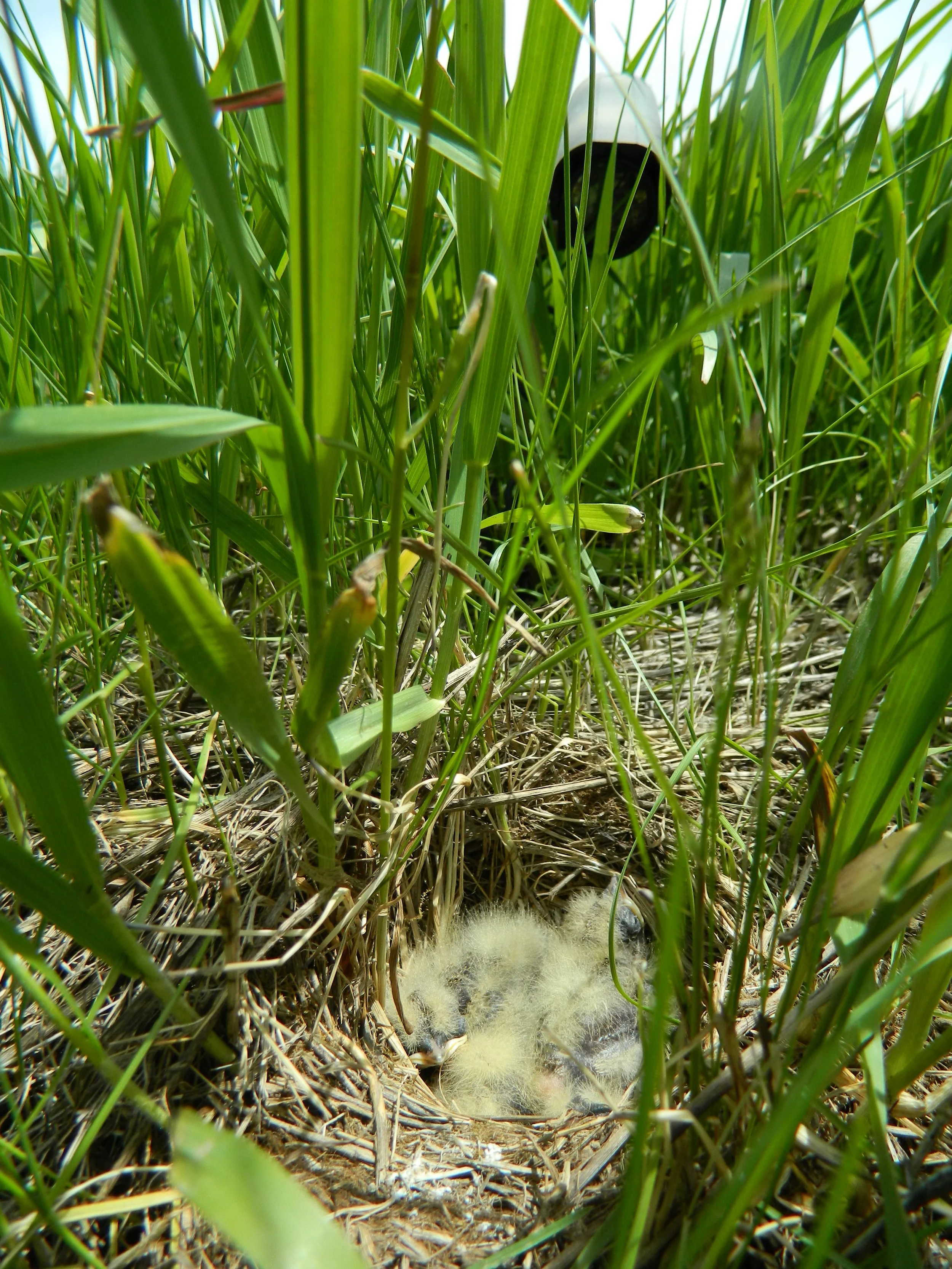This series highlights the fascinating and marvelous ecology of grassland bird nesting, written by Madison Audubon education director Carolyn Byers. Click here for all Into the Nest posts.
The grassland birds that we’ve been following this summer have completed the arduous journey back to Wisconsin, set up territories, and found mates. They have built a nest and laid a clutch of breathtakingly beautiful eggs. Now they need to ensure the eggs survive until hatching-- no small feat.
A lovely common yellowthroat nest is tucked down into the grass. This photo was taken from about 4 feet above the nest, and demonstrates just how well hidden they are. Photo by Carolyn Byers
Birds incubate their eggs to keep them at the correct temperature for development. Specifically, between 98.6 and 104 degrees Fahrenheit. This may mean warming or cooling the eggs depending on the weather. Their main tools for regulating egg temperature are their body and nest they built (remember those microclimates we were discussing earlier?).
Birds that are incubating eggs have a brood patch on their chest: an area lacking feathers that has increased blood flow to the tissue (it is highly vascularized). This patch of skin is wrinkly and loose, and allows the bird to transfer heat very efficiently to the eggs. As the bird sits down on the eggs to incubate, it wiggles its body to ensure the brood patch makes good contact with the eggs. When a bird is away from the nest the feathers next to the brood patch cover the bare area, keeping the adult warm and protecting that delicate skin.
Here, a scientist blows on an American robin’s belly, revealing her brood patch. Photo by VSPYCC
Here is another example of a brood patch, this time on a Pied Flycatcher (not a Wisconsin bird!) . Photo by Jean-Lou Zimmermann / Biosphoto
Birds typically lay one egg each day until they have a full clutch -- whatever that clutch size may be for their species. Most birds begin incubating as soon as the clutch is complete. This ensures that the eggs will develop at the same rate and hatch at approximately the same time. Henslow’s sparrow and Eastern meadowlark both do this.
These four eastern meadowlark chicks are all 11 days old. They are all generally the same size, and their plumage is at the same stage of development. Photo by Carolyn Byers
Some birds begin incubating with the penultimate, or the second-to-last, egg. Savannah sparrow, grasshopper sparrow, bobolink, dickcissel do this (though sometimes dickcissel begin to incubate with the last egg). One egg will be a day behind the others, and when they hatch, one chick will be smaller than the others. The last egg is the built-in “runt” of the clutch. If conditions are right and there is more than enough food to go around, all of the chicks will likely survive. If harsh weather or some other event makes it harder for the parents to feed their entire clutch, one chick will already be weaker than the others. The chicks that beg the loudest for food get fed first, and a runt will not last long in a food-limited nest. This may seem harsh, but it gives parents a better chance of raising a few healthy chicks rather than a full clutch of weaklings. Healthy chicks are more likely to survive until their first breeding season when they can pass on their parents’ genes.
A few birds take this to the extreme and have chicks hatch sequentially for several days. American robins begin incubation after the second egg is laid, and Northern harriers may start incubating immediately after their first egg. This creates a clear distinction between sizes and ages of each chick, giving the oldest a very good chance of survival.
These northern harrier chicks are all at least a day apart in age. The two chicks on the right of the nest are older than the ones on the left. Photo by Carolyn Byers
Incubation Behavior
For most of our grassland birds, only the female incubates. Occasionally there will be a study where a male was observed a bit of time at the nest, but that is rare. Males occasionally help the female during the incubation period. Male harriers may shade or guard the eggs if the female leaves, he also provides food for the female while she incubates. Male bobolinks visit the nest often, but do not feed the female.
Watching videos of birds incubating eggs makes me wish they could learn to knit. Or read. Or do crosswords. Studies have shown that the more activity that takes place at a nest, the more likely a predator is to find it. And so, natural selection has favored birds that reduce their activity around the nest. For the most part, the incubating birds just sit there trying not to be noticed. They may spend some time preening or doing a little nest maintenance. If a tasty insect wanders by, they may reach out and snag it. They really just maintain egg temperature.
See, doesn’t this eastern meadowlark look like she’d enjoy a nice sudoku? Image from eastern meadowlark nest camera footage provided by U.S. Geological Survey, Wisconsin Cooperative Wildlife Research Unit, Madison, WI
Studies from Wisconsin have shown bobolink incubation bouts to average 19 minutes (Renfrew et al. 2015). Unless a male is feeding her, females need to leave the nest to forage for food. This forces the female to create a delicate balance between time spent at the nest adjusting egg temperature and time spent foraging to ensure the female has enough calories to survive the night.
The only other important task an incubating bird has (other than keeping those eggs at an ideal temperature) is egg rotation. They rotate the eggs to rearrange the clutch, giving each egg a chance to be directly under the adult. Turning the eggs also ensures that the embryos develop correctly, and allowing chicks to absorb nutrients efficiently. Rotation keeps the chorioallantois (a protective membrane that surrounds the embryo) from sticking to the inner shell. You can read more about egg rotation in this National Audubon article: Incubating bird eggs is more complex than you think.
An eastern meadowlark rotates her eggs. Image from eastern meadowlark nest camera footage provided by U.S. Geological Survey, Wisconsin Cooperative Wildlife Research Unit, Madison, WI
* * * * * * * * * * * *
We’re finally discussing a topic that we have video footage for! Before you check it out, there are a few things I want to you keep in mind:
Horned lark chicks are blissfully unaware of the nest camera in the background. Photo by Carolyn Byers
First and foremost, remember that from the time we began looking for nests until each nest finished, keeping those birds safe was our number-one priority. Please visit my webpage to find out more about our methods -- everything from nest searching and checking to setting up cameras.
Second, this footage is not hi-def. It doesn’t compare to Planet Earth, or even most of the popular nest cameras that are online. BUT, these videos were all captured in 2005-2011. This was before the technology was cheap, and we needed to have about 25 cameras on hand. The cameras needed to be tiny and well camouflaged. They were hidden down in the grass, where an unobstructed view of the nest was hard to find while respecting the birds’ space. So, enjoy these videos for what they are: really rare footage of grassland bird nests -- but not necessarily the most beautiful footage you’ve ever seen. Hopefully what we’ll be showing you will be so cool that you won’t even notice the grainy images!
Nest Camera Footage
Eastern Meadowlark Nest Incubation
An eastern meadowlark mama returns to her nest and wiggles to ensure her brood patch is fully touching her eggs. Note her open mouth: she’s using gular fluttering to keep cool (basically panting: evaporative cooling using her mouth).
0:24 She switches to shading her eggs: she stands up, extends her wings a bit, and the shade from her body and the increased availability of the breeze cools the eggs.
0:34 She repositions one egg, then sits back down again, again maximizing contact between her brood patch and the eggs.
Bobolink Nest Incubation
0:0 A female bobolink leaves and returns to her nest several minutes later; she wiggles to ensure her brood patch is fully touching her eggs.
0:21 She preens herself before sitting back down on the eggs.
0:45 She repositions the eggs, then sits back down again.
1:25 She does nest maintenance, one of the more exciting activities one can do while on the nest.
1:40 She preens again, this time sitting in the opposite direction so gives the camera nice views of her body and activity!
* * * * * * * * * * * * * * * * * * * * * * * *
Dickcissels are a beautiful, migratory grassland bird that benefits from the Migratory Bird Treaty Act. Photo by Kelly Colgan Azar
This summer, to celebrate Year of the Birdand 100 years of bird conservation under the Migratory Bird Treaty Act, we’ll be posting regular articles about grassland bird nesting ecology. My M.S. thesis focused on grassland bird nesting ecology, and I’m excited to share my knowledge—and stories from the field- with you! We’ll go into the nest to learn about chick behavior, adult sleep habits, feeding and fledging. We’ll discuss predation and learn about how adult birds respond to different predators. You’ll get to see beautiful photos of nests, eggs, and chicks, as well as video footage straight from the nest! Best of all, the next time you’re out hiking in your favorite Wisconsin prairie, you’ll feel a bit closer to the birds you love.
If you’re interested in reading more and can’t wait for the next post, you can read more about my thesis work here.
Stay tuned for our next edition of Into the Nest, coming soon!
Written by Carolyn Byers, Madison Audubon education director
Video credit:
Nest footage was generously provided by the U.S. Geological Survey, Wisconsin Cooperative Wildlife Research Unit, Madison, WI. Check out their website to learn more!
Works cited:
Renfrew, R., A. M. Strong, N. G. Perlut, S. G. Martin, and T. A. Gavin (2015). Bobolink (Dolichonyx oryzivorus), version 2.0. In The Birds of North America (P. G. Rodewald, Editor). Cornell Lab of Ornithology, Ithaca, NY, USA. https://doi.org/10.2173/bna.176













